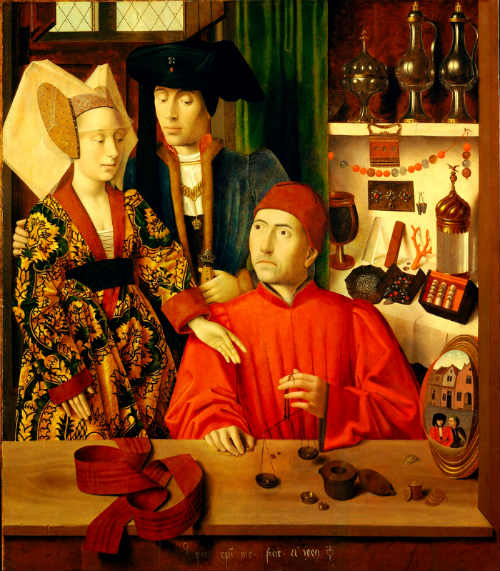Search:: Artists Alphabetically Artists by Country Artists by Century Artists by Movement
Petrus Christus
1375-1444
One of the Greatest Painters Of All Time
Early Netherlandish Northen Renaissance Painter
Stylistically influenced by the following painters manuscript illuminations and Jan van Eyck

A Goldsmith
In His Shop c.1449
by Petrus Christus
Petrus Christus was one of the greatest painters of the Northern Renaissance. His paintings, are filled with layer upon layer of fascinating symbolic meaning. Author Carleton Noyes exsplains "The symbolic character of a work of art must not be lost from sight, for it is the clue to the interpretation of pictures, as it is of all art. The painter feels his way through the gamut of his palette to a harmony of color just as truly as the musician summons the notes of his scale and marshals them into accord. The painter is moved by some sweep of landscape; it wakens in him an emotion. When he sets himself to express his emotion in the special medium with which he works, he represents by pigment the external aspect of the landscape, yes; but not in order to imitate it or reproduce it: he represents the landscape because the colors and the forms which he registers upon the canvas express for him the emotions roused by those colors and those forms in nature. He does not try to match his grays with nature's grays, but this nuance which he gropes for on his palette, and having found it, touches upon his canvas, expresses for him what that particular gray in nature made him feel. His one compelling purpose is in all fidelity and singleness of aim to "translate the impression received." The painter's medium is just as symbolic as the notes of the musician's nocturne or the words of the poet's sonnet, equally inspired by the hour and place. Color and line and form, although they happen to be the properties of things, have a value for the emotions as truly as musical sounds: they are the outward symbol of the inward thought or feeling, the visible bodying forth of the immaterial idea."
Diffrences Between Northern Renaissance and Italian Renaissance Art
Many of the early paintings of the Northern Renaissance perished through time and the fierceness with which the Iconoclastic battles were waged. The Northern Renaissance was different from the Italian Renaissance in many ways. Painters of the North focused upon secular society rather than the Church and overblown religious themes. Northern Renaissance painters emphasis the daily life of the merchant and peasant class. They also put a greater emphasis on spirituality, piousness and living a simple life. Artists such as Dieric Bouts and Peter Brugal the Elder painted inspirational biblical scenes, the merchant class at work, idyllic scenes of peasants working at everyday tasks, playing games and feasting. Northern Renaissance painters seemed more in touch with the people. According to art historian John C. Van Dyke "As a whole their subjects were single figures or small groups in interiors, quiet scenes, family conferences, smokers, card-players, drinkers, landscapes, still-life, architectural pieces. ."The Italian Renaissance, on the other hand, focused more on the aristocracy and the theocracy. Painters highlighted the individual and glorified worldly pleasures, Paintings were sumptuous, elaborate, expressive, and exhalted wealthy and powerful people. Author Clive Bell observed "But whatever the Italian painters of the Renaissance had to say they said in the grand manner. Remember, we are not Dutchmen. Therefore let all your figures suggest the appropriate emotion by means of the appropriate gesture—the gesture consecrated by the great tradition. Straining limbs, looks of love, hate, envy, fear and horror, up-turned or downcast eyes, hands outstretched or clasped in despair."
The Italian Renaissance painters focused heavily on religion, Roman Catholicism. Popes and church hierarchy were wealthy, powerful rulers. Like kings they were depicted in elaborate settings swaddled in furs and silks.
Important Words, People, Phrases, Chactoristics related to the Northern Renaissance Art Movement - allegorical painting, rebirth, 1 point perspective, Hieronymus Bosch, Limbourg Brothers, Desiderius Erasmus, Robert Campin, Jan Van Eyck, Jean Fouquet, Albrecht Dürer, Johannes Gutenberg, Johann Reuchlin, Martin Luther, rise of the merchant class, Protestant Reformation, glazing, impasto, scriptorium, illuminator, invention of the printing press, woodcuts, engravings, Antwerp, commerce, Northern Europe, Antwerp, Flanders, Bruges, renewed interest in classical learning, mythological scenes, genre painting, landscapes, portraits, moralizing overtones, human vices, lust, Protestant Reformation, paradise, spirituality, piousness, living a simple life, reform, Human Reasoning, tradesmen at work, idyllic scenes of peasants, playing games, feasting, linear perspective, Heliocentric Theory, humour, satire, spiritually significant, illuminated manuscript, idealized biblical themes, scriptorium, emotion, illuminator, iconoclast, Age of Discovery, Virgin and Child, axonometric drawing, curiosity about the natural world, realistic use of colours and light, Old Testament stories, Gospel parables, The Blackdeath, Christian symbolism
Require more facts and information about Rogier van der Weyden and Art history? Dig around every nook and cranny of the known universe for information this subject. Search Here
☼☼☼☼☼
© HistoryofPainters.com If you like this page and wish to share it, you are welcome to link to it, with our thanks. updated 3/7/2017